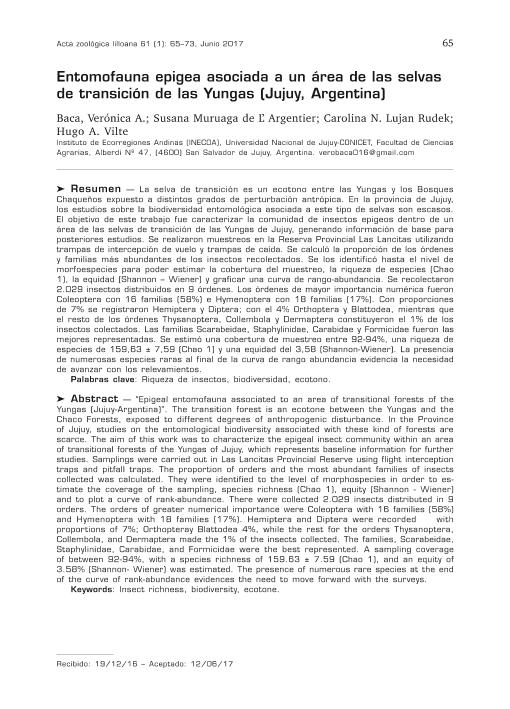Artículo
La selva de transición es un ecotono entre las Yungas y los Bosques Chaqueños expuesto a distintos grados de perturbación antrópica. En la provincia de Jujuy, los estudios sobre la biodiversidad entomológica asociada a este tipo de selvas son escasos. El objetivo de este trabajo fue caracterizar la comunidad de insectos epigeos dentro de un área de las selvas de transición de las Yungas de Jujuy, generando información de base para posteriores estudios. Se realizaron muestreos en la Reserva Provincial Las Lancitas utilizando trampas de intercepción de vuelo y trampas de caída. Se calculó la proporción de los órdenes y familias más abundantes de los insectos recolectados. Se los identificó hasta el nivel de morfoespecies para poder estimar la cobertura del muestreo, la riqueza de especies (Chao 1), la equidad (Shannon – Wiener) y graficar una curva de rango-abundancia. Se recolectaron 2.029 insectos distribuidos en 9 órdenes. Los órdenes de mayor importancia numérica fueron Coleoptera con 16 familias (58%) e Hymenoptera con 18 familias (17%). Con proporciones de 7% se registraron Hemiptera y Diptera; con el 4% Orthoptera y Blattodea, mientras que el resto de los órdenes Thysanoptera, Collembola y Dermaptera constituyeron el 1% de los insectos colectados. Las familias Scarabeidae, Staphylinidae, Carabidae y Formicidae fueron las mejores representadas. Se estimó una cobertura de muestreo entre 92-94%, una riqueza de especies de 159,63 ± 7,59 (Chao 1) y una equidad del 3,58 (Shannon-Wiener). La presencia de numerosas especies raras al final de la curva de rango abundancia evidencia la necesidad de avanzar con los relevamientos. The transition forest is an ecotone between the Yungas and the Chaco Forests, exposed to different degrees of anthropogenic disturbance. In the Province of Jujuy, studies on the entomological biodiversity associated with these kind of forests are scarce. The aim of this work was to characterize the epigeal insect community within an area of transitional forests of the Yungas of Jujuy, which represents baseline information for further studies. Samplings were carried out in Las Lancitas Provincial Reserve using flight interception traps and pitfall traps. The proportion of orders and the most abundant families of insects collected was calculated. They were identified to the level of morphospecies in order to estimate the coverage of the sampling, species richness (Chao 1), equity (Shannon - Wiener) and to plot a curve of rank-abundance. There were collected 2.029 insects distributed in 9 orders. The orders of greater numerical importance were Coleoptera with 16 families (58%) and Hymenoptera with 18 families (17%). Hemiptera and Diptera were recorded with propor tions of 7%; Or thopteray Blattodea 4%, while the rest for the orders Thysanoptera, Collembola, and Dermaptera made the 1% of the insects collected. The families, Scarabeidae, Staphylinidae, Carabidae, and Formicidae were the best represented. A sampling coverage of between 92-94%, with a species richness of 159.63 ± 7.59 (Chao 1), and an equity of 3.58% (Shannon- Wiener) was estimated. The presence of numerous rare species at the end of the curve of rank-abundance evidences the need to move forward with the surveys.
Entomofauna epigea asociada a un área de las selvas de transición de las Yungas (Jujuy, Argentina)
Título:
Epigeal entomofauna associated to an area of transitional forests of the Yungas (Jujuy-Argentina)
Baca, Verónica Andrea ; Muruaga de L'argentier, Lidia Susana; Lujan Rudek, Carolina Natacha
; Muruaga de L'argentier, Lidia Susana; Lujan Rudek, Carolina Natacha ; Vilte, Hugo
; Vilte, Hugo
 ; Muruaga de L'argentier, Lidia Susana; Lujan Rudek, Carolina Natacha
; Muruaga de L'argentier, Lidia Susana; Lujan Rudek, Carolina Natacha ; Vilte, Hugo
; Vilte, Hugo
Fecha de publicación:
06/2017
Editorial:
Fundación Miguel Lillo. Dirección de Zoología
Revista:
Acta Zoológica Lilloana
ISSN:
0065-1729
e-ISSN:
1852-6098
Idioma:
Español
Tipo de recurso:
Artículo publicado
Clasificación temática:
Resumen
Palabras clave:
Insectos
,
Biodiversidad
,
Selva
,
Riqueza
Archivos asociados
Licencia
Identificadores
Colecciones
Articulos(SEDE CENTRAL)
Articulos de SEDE CENTRAL
Articulos de SEDE CENTRAL
Citación
Baca, Verónica Andrea; Muruaga de L'argentier, Lidia Susana; Lujan Rudek, Carolina Natacha; Vilte, Hugo; Entomofauna epigea asociada a un área de las selvas de transición de las Yungas (Jujuy, Argentina); Fundación Miguel Lillo. Dirección de Zoología; Acta Zoológica Lilloana; 61; 1; 6-2017; 65-73
Compartir



